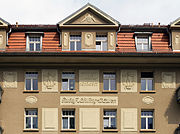Rudolf Schilling
Georg Rudolf Schilling (June 1, 1859 - December 19, 1933) was a German architect.[1] He was associated with the Dresden architecture firm Schilling & Graebner.[2]
Early life
Born as a son of the sculptor Johannes Schilling.[3] He studied architecture at the Dresden Polytechnic from 1879, where he was particularly influenced by Professor Karl Weißbach. Here Schilling also got to know Julius Graebner, who would later become his partner in a joint architectural office. From 1880 the study was for one year because of his military service with the Saxon Army. It interrupted, only to be completed in 1883. Thereafter Schilling worked temporarily in an architecture firm in Munich and from 1884 to 1886 in Berlin with Hermann Ende and Wilhelm Böckmann. He then settled as an independent architect in his place of birth and study in Dresden.[4][5]

Career
In 1889 he founded the Schilling & Graebner office together with his former fellow Julius Graebner.[6] Together, they created primarily in Saxony a plurality of first historical building, then at Nouveau and the reform architecture of the early Modern oriented churches, administration buildings, private houses, large residential complexes and other buildings. Schilling had the title of a royal building council. After his business partner Julius Wilhelm Graebner died in August 1917, Schilling ran the architecture firm Schilling and Graebner with his son Erwin Graebner.[6]
Schilling himself died in 1933 of a stroke and his burial is located on the St. John's Cemetery in Tolkewitz.[5]
Notable works
Before working with Julius Wilhelm Graebner, Schilling essentially designed two buildings on Pillnitzer Straße in the suburb of Pirnaische Vorstadt around 1887.[7] These are the Schilling Museum of the Dresden Municipal Collections and the Schilling family home.[8] Both were destroyed and not rebuilt in the February 13, 1945 bombing.[9] The other works were created in the Schilling & Graebner office and are noted in the article there.
References
- "Schilling, Georg Rudolf - Deutsche Biographie". www.deutsche-biographie.de (in German).

- "Biografie von Rudolf Schilling (1859-1933) - Sächsische Biografie | ISGV e.V." saebi.isgv.de. Retrieved 23 July 2020.
- "Vita and Opus - The Schilling Association". schilling-association.org. Retrieved 23 July 2020.
- "GRIN - Villenbauten der Jahrhundertwende in Dresden. Die Beiträge des Architekturbüros Schilling & Graebner". www.grin.com (in German).
- "Rudolf Schilling - Stadtwiki Dresden". www.stadtwikidd.de.
- Hans-Holger Malcomeß (2015-02-08). "Die Entwicklung des protestantischen Kirchenbaus der Dresdner Architekturfirma Schilling und Graebner zwischen 1889 und 1917" (PDF). Archived from the original (PDF; 947 kB) on 2016-02-22. Retrieved 2001-09-30.
- "Hopfgartenstraße - Dresdner Stadtteile". www.dresdner-stadtteile.de. Retrieved 23 July 2020.
- "Schilling-Museum". www.europeana.eu. Europeana is an initiative of the European Union.
- Fischer-Defoy, Christine; Crossley, Paul (1986). "Artists and Art Institutions in Germany 1933-1945". Oxford Art Journal. pp. 16–29.
External links
- Literature by and about Rudolf Schilling in the German National Library catalogue